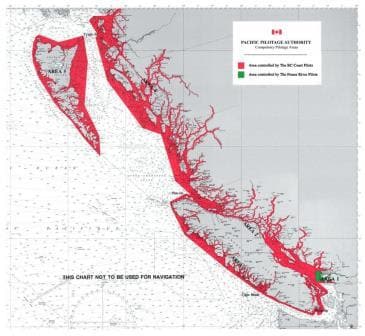With our sightseeing done and a late Seymour Narrows tide the Zaandam took the wide route through Queen Charlotte Sound. This area is outside the compulsory B.C Pilots coverage and thus we could say goodbye to the Pilots just before 08.00 hrs. at Pine Island. Not that we saw much of Pine Island as once again we had restricted visibility and we were sailing inside a very small world.
The B.C pilots are on board because we sail the Inside Waters of British Colombia. As with the rest of the world, the moment you come within the 3 miles of land, you fall under the jurisdiction of the country which borders at the sea. When you come within 3 miles of the B.C coast with the intention of going inland you need pilots. Understandable as the local government would like to have representative on board to ensure that the ship coming in, knows what it is doing. Secondly, even if it knows what it is doing, it might not have enough knowledge to sail safely through the area.
That is ever so true for the BC Inside Passage. You need a lot of local knowledge to sail safely through it. I think now with 35 years on the coast and with over 300 cruises here under my belt, I would be able to sail the area safely. But you never know what that other ship would do, if that was allowed to operate without a pilot as well. Thus we have pilots on board on every ship over 300 tons and the world is much the better for it.

BC pilots coverage area. According to the chart from their website. With thanks for using it. Everything in red is covered by Pilot requirements and services.
All these pilots have a lot of local knowledge and most of them have started out as deck hands on the tugboats. And if there is a way to learn how to deal with currents and “going around the corner” in the Inside Passage, it is with getting your experience on a tugboat. Some tugs only make 5 or 6 knots of speed and with 6 knots against you, the phrase “making head way” suddenly gets a whole new dimension. Same for going around the corner; making six knots with a big barge behind you and then having four knots current on the side. That can also result in a very peculiar way of travelling. I have seen barges almost over taking the tugboat and I have tug and tows giving up on going through Seymour Narrows as they missed the window and sought shelter out of the current to wait for the next slack tide.
To pick up the pilots there are basically three stations. One is Triple Island on the border between Canada and the USA. Here ships collect a pilot for going to Prince Rupert or through the Inside Passage to other destinations including Vancouver. Then there is Pine Island which mainly serves the cruise ships and is there to give the option for the ships to stay in the schedule to and from Vancouver, if Seymour Narrows slack tide is at an odd time. Odd meaning, it is not in synch with the cruise schedule of the ship. Location number 3 is Victoria, which serves all the ships coming up from the Pudget Sound and from Strait Juan de Fuca.
Because of our longer transits we have two pilots on board, who alternate watches. Those watches are nothing compared to the regular watches the navigators stand. The pilots split the time up evenly between them and in such a way that they have the best rest hours possible. Only on transits shorter than 8 hours, we can do it with one pilot. That works very well from Victoria to Vancouver and vice versa. The distance is about 90 miles and including arrival and departure you can do that in about 6 hours.
As a result of Pine Island pilot station the Zaandam sailed without pilots for the remainder of the day. Queen Charlotte Sound is of course Canadian Waters but it is so wide, that the legislator decided that ships can sail here without a pilot.
The next pilot we will get is the Alaska pilot who will board tomorrow morning around 05.15 Alaskan Time. We will follow the Ruby Princess and the Golden Princess in, which are docking at berth 4 and 3. Those docks are further up the harbor in Ketchikan and to avoid everybody having to overtake each other, the whole parade sequence is already arranged before the ships arrive at the pilot station.
Weather for tomorrow: regular Ketchikan weather………………rain.

Leave a Reply